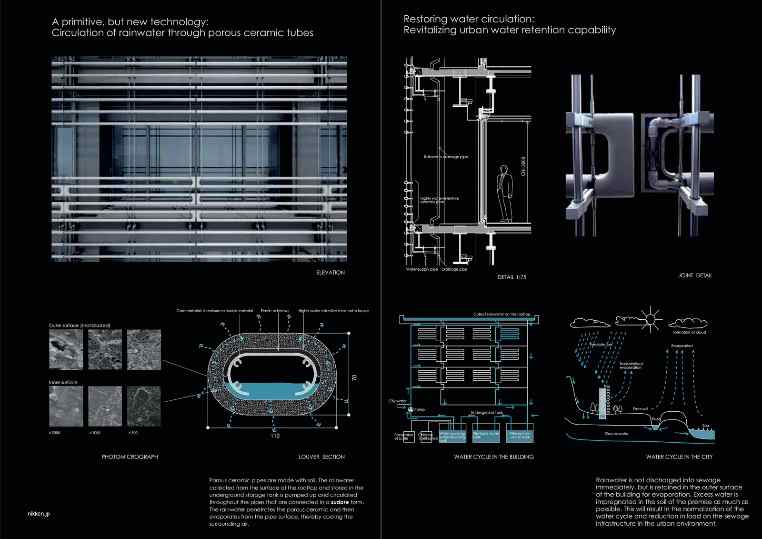Day 1 :
Keynote Forum
Mahmoud Nili-Ahmadabadi
Director at Center of Excellence (COE) for High Performance Materials, Iran
Keynote: On the two way shape memory effect of NiTi/NiTiCu bi-layer composites; experimental and numerical study
Time : 11:40-12:20

Biography:
Mahmoud Nili Ahmadabadi is professor at university of Tehran, is teaching and working on phase transformation of metals and alloys. Different alloys have been the subject of his research, liquid-solid phase transformation, bulk metallic glass or solid-solid phase transformation. In the latter case, shape memory and pseudoelasticity in Fe base or NiTi alloys is one of his recent major research subjects. In the case of NiTi alloys he and his team introduces bi-layer bulk and thin film shape memory NiTi alloys which show intrinsic two way shape memory effect with faster response during loading and unloading.
Abstract:
NiTi/NiTiCu bi-layer composite as a bulk novel material, which shows pseudo-elastic and shape memory properties simultaneously, was made by diffusion bonding method. In addition similar bi-layer but thin film was prepared by deposition onto Si (111) substrates by RF magnetron sputter deposition from separate alloy targets. The interface of bonding of bulk material was investigated by SEM and chemical composition gradient in the interface zone analyzed using line scan analysis with energy dispersive X-ray spectroscopy. In the case of thin film, grazing incidence X-ray diffraction, transmission electron microscopy, electrical resistivity and nano-indentation were used for characterization. An analytical model and FEM study was employed in order to investigating the tensile behavior of composites during loading and subsequent unloading. The solutions of the analytical method are validated with the numerical simulations as well as the experimental results. The chemical and stress gradient in the bi-layers affects the structure, phase transformation and shape memory effect. The bi-layers exhibit multi step phase transformation and intrinsic two-way SME with a reduced hysteresis without complicated training. Considering the results of the analytical modeling, the numerical simulations and the experiments, it is evident that the bi-layer composites with different thickness ratios provide adjustable mechanical behavior that can be considered in different applications design, e.g., actuators, equipped with shape memory components.
Image
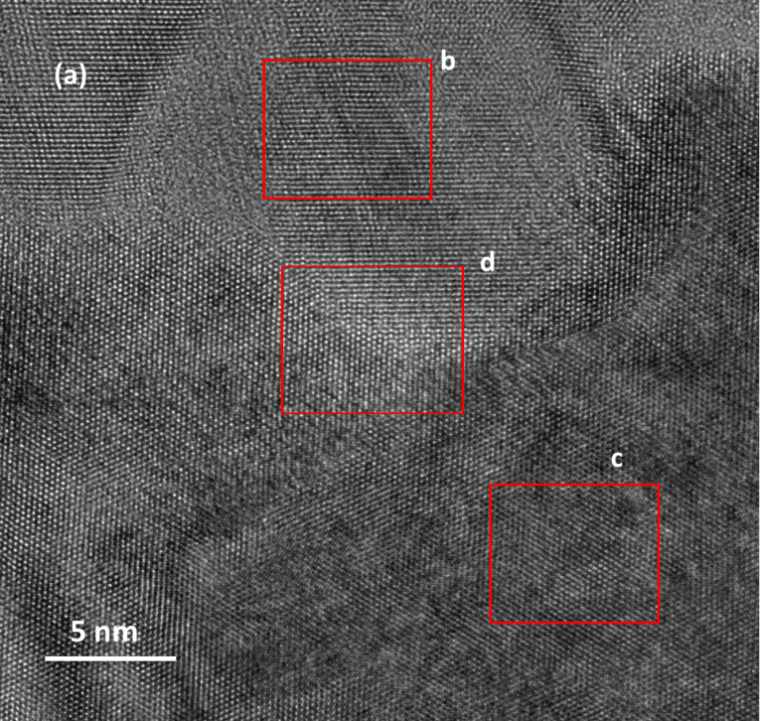
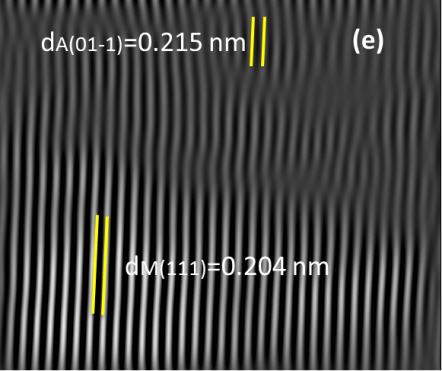
Figure-1: (a) HRTEM image and (e) corresponding inverse FFT image of the interface.
Recent Publication
- Mohri M, Taghizadeh M, Wang D, Hahn H, Nili-Ahmadabadi M (2018) Microstructural study and simulation of intrinsic two-way shape memory behavior of functionally graded Ni-rich/NiTiCu thin film. Materials Characterization; 135: 317-324.
Reference
- Mohri M, Nili-Ahmadabadi M, Pouryazdan Panah M, Hahn H (2016) Evaluation of structure and mechanical properties of Ni-rich NiTi/Kapton composite film. Materials Science and Engineering A; 668: 13-19.
Keynote Forum
Xiaozhong Zhang
Tsinghua University, China
Keynote: Semiconductor Nonlinear Effect Assisted Magnetoresistance and Magnetic Logic
Time : 11:00-11:40

Biography:
Xiaozhong Zhang completed his PhD in1989 from University of Oxford and postdoctoral studies at The Royal Institution of Greast Britain in 1992. Then he worked as a faculty at National University of Singapore for seven years. Since 1999 he has been working as a professor at School of Materails Science and Engineering of Tsinghua University. He is now the deputy director of the Key Laboratory of Advanced Materials, Education Ministry, and is serving as the deputy chief of Chinese national nano-technology standardization committee. He has published more than 190 papers in referred journals and is a co-editor of IUCrJ.
Abstract:
Discovery of giant magnetoresistance (MR) won Nobel Prize in Physics in 2007 and it initiated spintronics. However, most MR devices are based magnetic materials which are not compatible with Si based devices. Coupling semiconductor nonlinear transport effect and Hall effect in semiconductor, we developed a Si-based geometrical enhanced MR device whose room-temperature MR ratio reaching 30% at 0.065 T. We also realized the geometrical enhanced MR in GaAs and Ge. We further coupled semiconductor nonlinear transport effect and anomalous Hall effect in a perpendicular magnetic anisotropic (PMA) material and realized a giant MR of 22000% at 1 mT in PMA material at room temperature. Based on our Si based MR device, we developed a current-controlled reconfigurable MR logic device, which could perform all four basic Boolean logic including AND, OR, NAND and NOR in one device. We proposed an alternative way to realize magnetoelectric logic by coupling spin-dependent transport effect in magnetic material and nonlinear transport effect in semiconductor material. All four basic Boolean logic operations could be performed with high output ratio. We further proposed a magnetic logic-memory device by coupling anomalous Hall Effect in magnetic material and negative differential resistance phenomena in semiconductor. All four basic Boolean logic operations could be programmed by magnetic bit at room temperature with high output ratio (>1000%) and low magnetic field (~5 mT). This device demonstrated that non-volatile information reading, processing and writing could be realized in one step and one device. Hence, logic and non-volatile memory could be closely integrated in one chip. The time and energy used in the processes of information transformation and transfer could be saved. This might break through the von Neumann performance bottleneck and make computer more energy efficiency and higher performance.
Image

Figure-1: Schematics of our magnetic device structure.
Recent Publications:
1. Luo ZC, et al. (2017) Large magnetoresistance in silicon at room temperature induced by onsite Coulomb interaction, Advanced Electronic Materials, 3:1700186.
2. Rajan R, et al. (2017) Diode and inhomogeneity assisted extremely large magnetoresistance in silicon, Applied Physics Letters 111: 042406.
References
- Luo Z C, et al. (2017) Large magnetoresistance in silicon at room temperature induced by onsite Coulomb interaction. Advanced Electronic Materials; 3: 1700186.
- Rajan, R, et al. (2017) Diode and inhomogeneity assisted extremely large magnetoresistance in silicon. Applied Physics Letters; 111: 042406.
- Wan C H, et al. (2011) Geometrical enhancement of low-field magnetoresistance in silicon. Nature; 477: 304-307.
- Luo Z C, et al. (2017) Reconfigurable magnetic logic combined with non-volatile memory writing. Advanced Materials; 29: 1605027.
- Luo Z C, et al. (2016) Extremely large magnetoresistance at low magnetic field by coupling nonlinear transport effect and anomalous Hall effect. Advanced Materials; 28: 2760–2764.
Keynote Forum
Raafat El-Halcha
University of Calgary, Canada
Keynote: Strengthening/reinforcing concrete structures using shape memory alloy
Time : 10:05-10:45

Biography:
Raafat El-Hacha is then Professor of Structural Engineering at the University of Calgary in the Department of Civil Engineering. He is the member of the International Institute for FRP in Construction (IIFC), American Concrete Institute (ACI), Canadian Society of Civil Engineers (CSCE) and Pre-stressed Concrete Institute (PCI). He is a Fellow member of the IIFC and the CSCE. He is the co-chair of Sub-Committee ACI 440-I “FRP Prestressed Concrete”, and chair of the CSCE Committee on “Advanced Composite Materials for Bridges and Structures”.
Dr. El-Hacha research interest focuses on using high performance advanced materials, such as FRPs, Shape Memory Alloy, Ultra-High Performance Concrete, for hybrid structural systems in bridge applications and other structures. He published over 220 journal and conference papers, co-authored 3 refereed design guidelines. Supervised and graduated 41 students. Served as guest editor for 3 journals, and edited/co-edited 8 conference proceedings. He is the recipient of several distinguished awards and fellowships including the IIFC President’s Award–2016, the CSCE Casimir Gzowski Gold Medal–2014, the Erasmus Mundus International Fellowship–2014 and 2013, the CSCE Excellence in Innovation in Civil Engineering Award–2011, and many others for his outstanding academic and professional experiences and achievements.
Abstract:
Shape memory alloy (SMA) has been attracting the researchers from different fields due to their superior properties. The SMA is a unique class of alloy with the ability to undergo large deformation as well as energy dissipation capacities while maintaining a super-elastic response and return to its original shape through stress removal (super elasticity) or heating (shape memory effect). SMA as internal reinforcement: The superior properties of SMA make it a good reinforcement candidate for the use in the seismic design of structures. The exceptional property of SMA in recovering substantial inelastic deformation upon unloading makes it very beneficial in seismic design. Thus, if SMA is used at the location of plastic hinges with proper design limitations, the structure will dissipate the demand energy and return to its original shape when unloaded. The design of self-centering concrete beam-column connections reinforced using SMA is an innovative proposal and can be optimized for the use in real-life construction. SMA in strengthening applications: Besides the material super-elasticity, corrosion and fatigue resistivity, SMA is mainly characterized by the shape memory effect that represents the ability of the SMA to recover its original shape after being deformed beyond the elastic limits through heating. The strain recovered in this transformation process can be utilized for pre-stressing applications by eliminating the use of hydraulic jacks. By having the pre-strained SMA reinforcement attached to the RC members and then applying heat above the activation temperature the SMA will recover the inelastic strain and thus a pre-stressing force will be developed in the RC member. The pre-strained SMA itself can be used as the pre-stressed reinforcement in flexural strengthening of RC beams as well as active confinement of RC columns.
Recent Publications and References
- Oudah, F., and El-Hacha, R., “Joint Performance in Concrete Beam-Column Connections Reinforced Using SMA Bars” Elsevier Journal of Engineering Structures. Vol. 151, November 2017, PP. 745-760.
- Rojob, H., and El-Hacha, R., “Self-prestressing using Fe-SMA for Flexural Strengthening of RC Beams,” ACI Structural Journal, Vol. 114, Issue 2, pp. 523-532, March-April 2017, 2017
- Rojob, H, and El-Hacha, R., “New Anchorage Mechanism for Smooth Fe-SMA Bar used for Flexural Strengthening of RC Beams using NSM Technique, “Proceedings of the 4th International Conference on Smart Monitoring, Assessment and Rehabilitation of Civil Structures (SMAR 2017), Switzerland, Zurich, 13-15 September 2017, (CD-Rom-8p.)
- Abdelrahman, K., and El-Hacha, R., “Finite Element Modelling of SMA Confined Concrete Columns.” Proceedings of the 4th International Conference on Concrete Repair, Rehabilitation and Retrofitting (ICCRRR 2015), Leipzig, Germany, 05-07 October 2015. 8p.
- Rojob H., and El-Hacha, R., “Flexural Strengthening of RC Beam Using NSM Iron-Based Shape Memory Alloys.” Proceedings of the ICCRRR 2015, Leipzig, Germany, 05-07 October 2015. 8p.
- Materials in Health and Biomedicine | Materials for Energy Storage and Applications | Material Science and Engineering | Market Demand and Value
Location: Dubai, UAE

Chair
Mahmoud Nili Ahmadabadi
University of Tehran, Iran

Co-Chair
Janah Shaya
University de Strasbourg, France
Session Introduction
Aman Ullah
University of Alberta, Canada
Title: Shifting to Biorefinery; Monomers, Biopolymers, Biosorbents and Biomaterials from Renewable Lipid Resources
Time : 12:20-12:50

Biography:
Aman Ullah received his PhD (with distinction) in Chemical Sciences and Technologies in 2010 at the University of Genova, Italy by working together at Southern Methodist University, USA. He worked as a postdoctoral fellow before accepting an Assistant Professor position at the University of Alberta. He has been promoted to Associate Professor with Tenure. He has been teaching a graduate course entitled “Renewable Biomaterials”. This course deals with fundamentals in bio-based materials development, characterization, and various industrial applications. Current research, recent literature, and real-life applications of biomaterials/bionanomaterials in various industries are discussed throughout the course. Aman has published more than 40 papers in reputed journals and 3 patents/patent applications. His research is focused on the development of biochemicals, biopolymers/biomaterials from lipids and other renewable resources. Overall, as PI and Co-investigator, he has attracted a total of ~ $8.7 million in funding in last 5 years. He has participated and presented his work in more than 82 National and international scientific meetings and conferences, including several invited, keynote and plenary lectures at conferences and research centers in Asia, Europe, and America. In addition, he has received several awards including Canadian Rising Star award in Global Health by Grand Challenges Canada in 2012.
Abstract:
In recent years, the use of renewable natural resources have become the focus of research in supplementing and/or replacing traditional petro chemical products due to growing energy demands and environmental concerns. The utilization of lipids and other renewable resources has been considered to play a primitive role towards sustainable development due to their large scale availability, built in functionality, bio degradability and no net carbon dioxide (CO2) production. In addition, a broad range of monomers can be obtained as a single feedstock. These attributes make lipids a good fit for the development of renewable bio materials. This presentation will focus on the conversion of lipids from various sources including waste streams such as waste cooking oil and lipids extracted from spent foul into monomers, bio polymers and bio materials for packaging water remediation, bio medical and other applications. The ability for complete conversion of oils in just few minutes under solvent free conditions into monomers, bio polymers and bio composites/nanocomposites is undoubtedly an attractive concept from both an academic and an industrial point of view.
Image
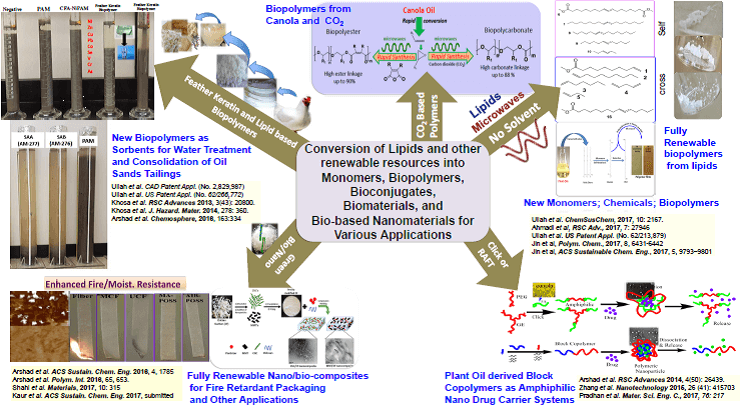
Figure-1: Bio materials from renewable resources.
Recent Publications
- Ahmadi R, Ullah A Microwave-assisted rapid synthesis of a polyether from a plant oil derived monomer and its optimization by Box–Behnken design (2017) RSC Advances; 7: 27946-27959.
- Jin Zeng, Ullah Rapid copolymerization of canola oil derived epoxide monomers with anhydrides and carbon dioxide (CO2) (2017) Polymer Chemistry; 8: 6431-6442.
- Ullah, A.; Arshad, M. Remarkably Efficient Microwave-Assisted Cross-Metathesis of Lipids in Solvent Free Conditions, ChemSusChem, 2017, 10, 2167-2174.
- Jin, L.; Geng, K.; Arshad, M.; Ahmadi, R.; Ullah, A. Synthesis of Fully Biobased Polyesters from Plant Oil, ACS Sustainable Chemistry & Engineering, 2017, 5, 9793–9801
- Kaur, Arshad, Ullah, In-Situ Nanoreinforced Green Bionanomaterials from Natural Keratin and Montmorillonite (MMT)/Cellulose Nanocrystals (CNC), ACS Sustainable Chem. Eng., 2018, 6 (2), pp 1977–1987
Janah Shaya
IPCMS, Strasbourg
Title: Towards High Performance Solvent-free Fluidic Devices
Time : 14:20-14:50

Biography:
Janah Shaya is a postdoctoral fellow and instructor with the CNRS at the IPCMS of Strasbourg (Institut de Physique et Chimie des Matériaux de Strasbourg) in collaboration with Kyushu University, Japan. He joined the IPCMS in October 2016. He got his PhD degree from University of Nice, Sophia Antipolis in France in September 2016 with honor distinction and medal. His work was peer-reviewed and selected for filming for the ACS website at the American chemical society in Philadelphia His principal axes of research are material sciences, biosensors, organic synthesis, photophysics electrochemistry, and applications (energy storage systems and CO2 valorization). He is currently the co-editor of two books on carbon dioxide and cross couplings with interchopen publisher
Abstract:
Solvent-free fluidic optoelectronics constitute a milestone research area that aims at fabrication of ultimate stretchable and flexible devices. The advantages of such non-volatile liquid optoelectronic materials compared to conventional solid-state ones are many i) intrinsic resilience, ii) excellent pore filling ability, iii) solvent-free processing, and iv) possibility to compensate for the degradation (via microfluidic technology), by supplying the device with fresh liquid.
In our lab, we have developed an efficient methodology to confer large aromatic species with a liquid state at room temperature, via functionalization by siloxane chains. A series of emitters and semiconductors and their applications have been executed including their investigations in OLEDs and solar cells. Among the reported results, oligofluorenes led to solvent-free liquid compounds that exhibit both remarkable charge transport properties and strong fluorescence.[3] The materials were found to exhibit ambipolar charge transport properties (hole- and electron-transport) with mobilities of about 10-4 cm2/Vs, i.e. a value comparable to the one of the best solid-state amorphous glasses used in various optoelectronic applications. These components allowed to realize the first distributed feedback (DFB) laser in a monolithic liquid semiconductor, given their high quantum yields (PLQY > 80 %) and extremely low threshold amplified stimulated emission (< 2 ïJ/cm2).
Overall, these results demonstrate that solvent-free liquid organic semiconductors functionalized by siloxane segments can compete in terms of photophysical and charge transport properties with organic glassy semiconductors, thus paving the way for the development of liquid optoelectronic devices.
Further, the optimization of the metal-catalyzed methodologies and the design of the optimal siloxane chains (length, branching, etc.) to synthesize liquid hosts at room temperature are illustrated based on various families such as carbazolebiphenyl derivatives
Image:

Figure. Photograph (at ambient and under UV light) of the strongly luminescent oligofluorene derivative functionalized with short siloxane chains, showing nonvolatile and stable liquid state at room-temperature. Graph (right) showing the temperature dependence of the ambipolar charge transport mobility, with typical recorded ToF signal in the insert.
Recent Publications:
- J.-C. Ribierre, L. Zhao, M. Inoue, P.-O. Schwartz, J.-H. Kim, K. Yoshida, A.S.D. Sandanayaka, H. Nakanotani, L. Mager, S. Méry, C. Adachi, Chem. Commun. 2016, 52, 3103
- J. Shaya, F. Fontaine-Vive, B. Y. Michel, A. Burger, “Rational design of push-pull fluorene dyes: synthesis and structure-photophysics relationship”, Chem. Eur. J. 2016, 22, 10627-10637.
- J. Shaya, M.-A. Deschamps , B. Y. Michel, A. Burger, “Air-stable palladium catalytic systems for sequential one-pot synthesis of challenging unsymmetrical aminated products”, J. Org. Chem. 2016, 81, 7566-7573.
- P.M. Holstein, D. Dailler, J. Vantourout, J. Shaya, A. Millet, O. Baudoin, “Synthesis of Strained γ-Lactams by Palladium(0)-Catalyzed C(sp3)–H Alkenylation and Application to Alkaloid Synthesis”, Angew. Chem. Int. Ed. 2016, 55, 1–6.
- N. P.F. Barthes, B. Y. Michel, J. Shaya, N. Martinet, A. Burger, “Génétique et épigénétique: Un code au-dessus du code”, Journal de la société chimique de France, 2016, 412, 20-27.
Biography:
Janah Shaya is a postdoctoral fellow and instructor with the CNRS at the IPCMS of Strasbourg (Institut de Physique et Chimie des Matériaux de Strasbourg) in collaboration with Kyushu University, Japan. He joined the IPCMS in October 2016. He got his PhD degree from University of Nice, Sophia Antipolis in France in September 2016 with honor distinction and medal. His work was peer-reviewed and selected for filming for the ACS website at the American chemical society in Philadelphia His principal axes of research are material sciences, biosensors, organic synthesis, photophysics electrochemistry, and applications (energy storage systems and CO2 valorization). He is currently the co-editor of two books on carbon dioxide and cross couplings with interchopen publisher
Abstract:
Solvent-free fluidic optoelectronics constitute a milestone research area that aims at fabrication of ultimate stretchable and flexible devices. The advantages of such non-volatile liquid optoelectronic materials compared to conventional solid-state ones are many i) intrinsic resilience, ii) excellent pore filling ability, iii) solvent-free processing, and iv) possibility to compensate for the degradation (via microfluidic technology), by supplying the device with fresh liquid.
In our lab, we have developed an efficient methodology to confer large aromatic species with a liquid state at room temperature, via functionalization by siloxane chains. A series of emitters and semiconductors and their applications have been executed including their investigations in OLEDs and solar cells. Among the reported results, oligofluorenes led to solvent-free liquid compounds that exhibit both remarkable charge transport properties and strong fluorescence.[3] The materials were found to exhibit ambipolar charge transport properties (hole- and electron-transport) with mobilities of about 10-4 cm2/Vs, i.e. a value comparable to the one of the best solid-state amorphous glasses used in various optoelectronic applications. These components allowed to realize the first distributed feedback (DFB) laser in a monolithic liquid semiconductor, given their high quantum yields (PLQY > 80 %) and extremely low threshold amplified stimulated emission (< 2 ïJ/cm2).
Overall, these results demonstrate that solvent-free liquid organic semiconductors functionalized by siloxane segments can compete in terms of photophysical and charge transport properties with organic glassy semiconductors, thus paving the way for the development of liquid optoelectronic devices.
Further, the optimization of the metal-catalyzed methodologies and the design of the optimal siloxane chains (length, branching, etc.) to synthesize liquid hosts at room temperature are illustrated based on various families such as carbazolebiphenyl derivatives
Figure. Photograph (at ambient and under UV light) of the strongly luminescent oligofluorene derivative functionalized with short siloxane chains, showing nonvolatile and stable liquid state at room-temperature. Graph (right) showing the temperature dependence of the ambipolar charge transport mobility, with typical recorded ToF signal in the insert.
Recent Publications (minimum 5)
- J.-C. Ribierre, L. Zhao, M. Inoue, P.-O. Schwartz, J.-H. Kim, K. Yoshida, A.S.D. Sandanayaka, H. Nakanotani, L. Mager, S. Méry, C. Adachi, Chem. Commun. 2016, 52, 3103
- J. Shaya, F. Fontaine-Vive, B. Y. Michel, A. Burger, “Rational design of push-pull fluorene dyes: synthesis and structure-photophysics relationship”, Chem. Eur. J. 2016, 22, 10627-10637.
- J. Shaya, M.-A. Deschamps , B. Y. Michel, A. Burger, “Air-stable palladium catalytic systems for sequential one-pot synthesis of challenging unsymmetrical aminated products”, J. Org. Chem. 2016, 81, 7566-7573.
- P.M. Holstein, D. Dailler, J. Vantourout, J. Shaya, A. Millet, O. Baudoin, “Synthesis of Strained γ-Lactams by Palladium(0)-Catalyzed C(sp3)–H Alkenylation and Application to Alkaloid Synthesis”, Angew. Chem. Int. Ed. 2016, 55, 1–6.
- N. P.F. Barthes, B. Y. Michel, J. Shaya, N. Martinet, A. Burger, “Génétique et épigénétique: Un code au-dessus du code”, Journal de la société chimique de France, 2016, 412, 20-27.
Manoj Gupta
National University of Singapore, Singapore
Title: Corrosion behaviour of Magnesium/Glass microballoon syntactic foams targeting engineering and biomedical applications

Biography:
Manoj Gupta is an Associate Professor at Department of Mechanical Engineering, National University of Singapore. He has been working on lightweight metals (particularly magnesium based materials) over past 25 years. His current research is focused on development of lightweight HEA, ignition resistant magnesium based nanocomposites, magnesium syntactic foams and additive manufacturing (3D printing) of magnesium.
Abstract:
Metal matrix syntactic foams (MMSFs) are a special class of composites in which hollow particles are dispersed through the metal matrix. The presence of hollow reinforcements imparts properties to the composite similar to that would be found in monolithic cellular materials. Such lightweight syntactic foams possessing superior properties are of continuing interest in automotive, aerospace and marine sectors to reduce weight while simultaneously increasing fuel economy required for ever-increasing stricter environmental regulations and stringent service conditions. In this context, magnesium-based materials are emerging strongly primarily due to their low density, combination of better specific strength (σ/ρ), damping characteristics and impact resistance. These properties can still be enhanced by a further reduction in density through the development of magnesium-based syntactic foams. Further, magnesium (Mg) being biocompatible offers huge potential for use as bioresorbable materials for degradable bone replacement implants due to its favorable corrosion and mechanical properties. However, high corrosion kinetics and localized corrosion progress limit wide scale implementation of magnesium based materials in marine environments and clinical implantable devices. This dire requirement necessitated the need for an investigation on corrosion behavior of hollow glass micro-balloon (GMB) reinforced magnesium syntactic foams. As environment of a human body is very aggressive to metallic products, the positive corrosion test results under simulated conditions of a human body provide a good indicator of the corrosion resistance of the material for other applications. This research presents a comparative study of the corrosion of Mg/GMB syntactic foams in Hank’s solution and in 3.5% NaCl solution for a maximum duration of 28 days. The developed syntactic foams were found to reveal promising corrosion behavior along with ~28% reduction in density as compared to pure Mg. The observed increase in corrosion resistance is correlated with intrinsic microstructural changes arising as a consequence of the presence of the hollow GMB particles.
Ray Gibbs
Haydale Limited, United Kingdom
Title: Near term commercial applications for Graphene, Composites and Conductive Pastes

Biography:
Ray Gibbs is a Chartered Accountant and former Deloitte Audit and Corporate Finance Partner for 9 years. He has over 20 years’ experience in high technology and fast moving consumer goods businesses and is a former CFO of Chemring Group Plc. He was part of Haydale Graphene Industries’ management team that acquired Haydale Limited in 2010, became CEO in 2013 and successfully took the business through to IPO in April 2014, defined the strategy and driven for globalization and now sales. He has been immersed into the graphene and nano world for 7 years
Abstract:
The potential for graphene and other nanoparticles to significantly enhance material properties has been well documented. However, as carbon is inert and does not mix well with other materials it needs to be homogeneously dispersed and bonded into the host material in order to realize its potential. There are hundreds of graphenes in the market today and all display different characteristics, from flake size, to thickness and chemical groups on the surface and ends to the supply chain issue in delivery of volume at a commercial cost. Some supply may well require scale up and the likelihood is that the volume output will be different from the pilot plant. Knowing which one material works best and applying a sympathetic surface treatment for a specific application is the Haydale expertise. This functionalization treatment plus the years of processing know how sets Haydale apart in the ability to commercialize nanomaterials. For industry to adopt these new materials we need to demonstrate a repeatable and cost effective supply chain that delivers a masterbatch to the customer. One of the challenges industry faces is that there is currently no standard definition of graphene which means that R&D and general procurement departments may not know exactly what it is they are not buying nor be able to replicate test results with a subsequent batch of material. Industry requires a standardization of materials to remove this uncertainty. The recent ISO paper has helped but there is a way to go. Recent work at Haydale has now confirmed significant improvements in electrical, thermal and mechanical performance of Carbon Fibre pre preg, opening up many applications now. Haydale has significant expertise in GRP and thermoplastic pipes for water, sewerage, and the oil and gas industry. With latter suffering for significant repair issues, leak detection and a desire to replace pipes with non-metallics, the Haydale team has unique solutions for these needs. These breakthroughs plus new pastes for bio medical sensors offers real short term commercial opportunities for grapheme and nanoparticles. The industrial and financial world has been waiting for these commercial applications to bear fruit. Further, in order to persuade industry to adopt the new materials we need to be able to incorporate the functionalized materials into existing production facilities thus avoiding the need for replacement of existing capital equipment. The author will examine these challenges and explain how Haydale has established a consistent supply chain of the nanomaterials and are addressing the commercial adoption challenges through the establishment of Centres of Excellence in strategic locations across the globe in the three dominant continents of The Far East, USA and Europe.
- Synthesis & Characterization | Smarter Lifestyle | Materials for Environmental Applications
Location: Dubai, UAE

Chair
Manoj Gupta
National University of Singapore, Singapore

Co-Chair
Janah Shaya
University de Strasbourg, France
Session Introduction
Lee D Wilson
University of Saskatchewan, Canada
Title: Responsive Biopolymer Materials: A study of their structure and adsorption properties
Time : 14:30-15:00

Biography:
Wilson is affiliated with the Department of Chemistry at the University of Saskatchewan and is an Associate Professor with research interests that cover diverse topics in physical chemistry, materials science and environmental chemistry. Ongoing research activities are focused on the development of new types of materials and studies related to adsorption and interfacial phenomena related to water science and technology. The Wilson research group is developing new forms sustainable biomaterials for the controlled removal of contaminants from water and chemical separations using methods based on green chemistry. This research contributes significantly to technology related to water and energy security that are especially important in various areas of agriculture, natural resources and the environment.
Abstract:
Statement of the Problem: There is a need to develop improved biopolymer adsorbents with responsive properties and enhanced adsorption toward target species for specialized applications in water treatment. In this study, polymer brushes and their iron oxide composites were prepared and characterized, along with the efficacy of methylene blue (MB) removal from aqueous solution. These “smart” materials were designed by grafting biodegradable polymers, poly acrylic acid (PAA) or poly itaconic acid (PIA) onto chitosan to yield pH-responsive polymer brushes of PAAgCHI, PIAgCHI and their magnetic nano composites (MNCs) containing iron oxide, respectively (Fig. 1). The MNCs are pH-sensitive and magnetically responsive adsorbents with switchable polymer morphology between swollen and collapsed states, along with the controlled adsorption and desorption of MB. Switchable MB uptake is based on the pH driven molecular recognition and conformational changes of brushes. The adsorption capacity of the materials varies between 421.2 to 470.2 mg g–1 with a removal efficiency of 99.2% (Fe3O4–PIAgCHI) and 99.5% (Fe3O4–PIAgCHI) for the MNCs. Sorbents can be recovered and efficiently regenerated by switching the pH of solution under an applied external field over five recycle steps. This work illustrates the potential utility of “smart” polymer brush systems for the remediation of model cationic dyes in wastewater. These eco-friendly sorbent materials possess excellent adsorption capacity, modular design, low cost, excellent regeneration, and rapid separation. Potential applications of these materials include the controlled removal of antimicrobials, pesticides, and personal care products from water and wastewater streams with high efficiency and recovery.
Figure 1:
Recent Publications
- Dolatkhah A, Wilson L D (2016) Magnetite/Polymer Brush Nanocomposites with Switchable Uptake Behavior Toward Methylene Blue. ACS Appl. Mater. Interfaces 8 (8): 5595–5607.
- Guo R, Wilson L D (2012) Synthetically Engineered Chitosan-Based Materials and their Sorption Properties with Methylene Blue in Aqueous Solution. J. Colloid Interface Sci. 388: 225–234.
- Casey L S, Wilson L D (2015) Investigation of Chitosan-PVA Composite Films and their Adsorption Properties. Journal of Geoscience and Environment Protection 3(2): 78-84.
- Karoyo, A H, Wilson L D (2016) Investigation of the Adsorption Processes of Fluorocarbon and Hydrocarbon anions at the Solid-Solution Interface of Macromolecular Imprinted Polymer Materials, J. Phys. Chem. C 120 (12): 6553–6568.
- 5. Dolatkhah A, Wilson L D (2018) Salt-Responsive Fe3O4 Nanocomposites and Phase Behavior in Water. Langmuir in press, DOI: 10.1021/acs.langmuir.7b03613.
Ray Gibbs
Haydale Limited, UK
Title: Near term commercial applications for Graphene, Composites and Conductive Pastes
Time : 15:00-16:00

Biography:
Abstract:
Vladimir Nazarov
Research Center for Applied Sciences, Academia Sinica, Taiwan
Title: Cross-over between collective and independent-particle excitations in quasi-2D electron gas with one filled miniband
Time : 16:15-16:45

Biography:
Vladimir Nazarov, (Ph.D.-physics), now is an Associate Research Fellow at the Research Center for Applied Sciences, Academia Sinica, Taiwan. He got his B Sc in physcics, M Sc physics from the Far-Eastern National University, Vladivostok, Russia, and his Ph.D. degree from the Institute for Automation and Control Processes, Far-Eastern Branch of Russian Academy of Sciences, Vladivostok, Russia. Currently Dr. Vladimir Nazarov's researches focus on the fundamentals of Time-Dependent Density-Functional Theory (TDDFT) and its applications to optics and transport in bulk materials and low-dimensional structures. Dr. Vladimir Nazarov has his Habilitation (in Russia, Doctor of Physical and Mathematical Sciences) from the Far-Eastern National University, Russia. The past positions of Dr. Vladimir Nazarov include the Leading Researcher at the Institute for Automation, Far-Eastern Branch of Russian Academy of Sciences, the Associate Professor at Kyushu Institute of Technology, Japan, Visiting Professor at the Institute for Solid State Physics, Japan, and Visiting Professor at Chonnam National University, South Korea.
Abstract:
While it has been recently demonstrated that, for quasi-2D electron gas (Q2DEG) with one filled miniband, the dynamic exchange fx, fx and fh kernels cancel each other in the low-density regime rs tends to infinity (by half and completely, for the spin-neutral and fully spin-polarized cases, respectively) [1], here we analytically show that the same happens at arbitrary densities at short distances. This motivates us to study the confinement dependence of the excitations in Q2DEG. Our calculations unambiguously confirm that, at strong confinements, the time-dependent exact exchange excitation energies approach the single-particle Kohn-Sham ones for the spin-polarized case, while the same, but less pronounced, tendency is observed for spin-neutral Q2DEG [2].
Image:
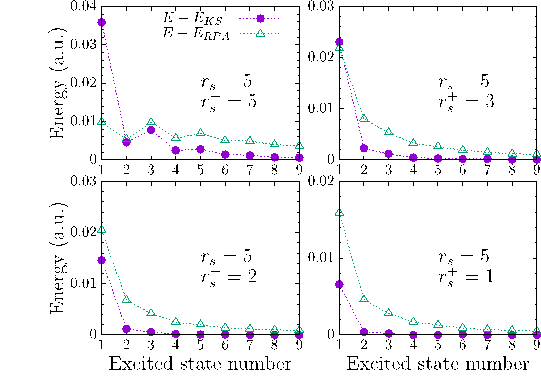
Fig.1. Time-dependent exact exchange (TDEXX), Kohn-Sham (KS), and Random Phase Approximation (RPA) excitation energies of the fully spin-polarized quasi-2DEG of the density parameter , confined with the strictly 2D uniform positive charge of the density parameter . For better visualization, each point is presented relative to the arithmetic mean of the TDEXX, KS, and RPA values.
Recent publications
1. V. U. Nazarov (2017) Quasi-low-dimensional electron gas with one populated band as a testing ground for time-dependent density-functional theory of mesoscopic systems, Physical Review Letters 118:236802.
2. V. U. Nazarov (2016) Exact exact exchange potential of two- and one-dimensional electron gases beyond the asymptotic limit, Physical Review B 93:195432.
References
1. V. U. Nazarov (2017) Quasi-low-dimensional electron gas with one populated band as a testing ground for time-dependent density-functional theory of mesoscopic systems, Physical Review Letters 118:236802.
2. V. U. Nazarov (2018) Crossover between collective and independent-particle excitations in quasi-2D electron gas with one filled miniband, arXiv:1802.07004 [cond-mat.mes-hall].
Ashok Ganapathy Iyer
Manipal Academy of Higher Education, Dubai
Title: Architectural documentation of heritage buildings in UAE
Time : 16:45-17:15

Biography:
Ashok Ganapathy Iyer is the Chairperson of School of Design & Architecture (SoDA), Manipal Academy of Higher Education Dubai (MAHE-Dubai). He is currently pursuing his PhD Studies at Welsh School of Architecture. His research interests are at the classification of the approaches to learning adopted by students in their design coursework through the five years of the architecture program. He has pursued his Masters in Architectural Studies at Sir J.J College of Architecture, Mumbai, India and Bachelor’s degree from Pillai College of Architecture, Navi Mumbai, India. He was a Faculty at Sir J.J College and Rizvi College of Architecture Mumbai. His other research interests include urban studies and historic architectural developments to construct pattern language, issues of sustainability in contemporary architecture, fine arts and architecture heritage cum documentation
Abstract:
Architectural documentation of heritage buildings in the United Arab Emirates has gained momentum in the past decade with the rapid urbanization of the Emirates including Abu Dhabi, Dubai and Sharjah, UAE. This has been spearheaded through various government departments focusing on architectural conservation of these historic buildings. The school has delved into architectural documentation as a part of the bachelor of architecture program to give students a hands-on insight of the built environment and deconstruct the details into drawings since 2012. As a part of this academic journey, Al Mahatta, the first airport of the Middle-East Region was documented in 2014-15. This documentation led to the consolidated project of preparing a conservation management plan for the museum. This was followed by two projects representing Al Mahatta within the urban fabric of the Emirate of Sharjah as-well-as the neighborhood where it is currently located. This paper delves into the importance of incorporating smart materials in architectural conservation. The paper further delves into the relevance of the technology domain in architectural education and the impact of smart materials of students’ approaches to learning.
Image
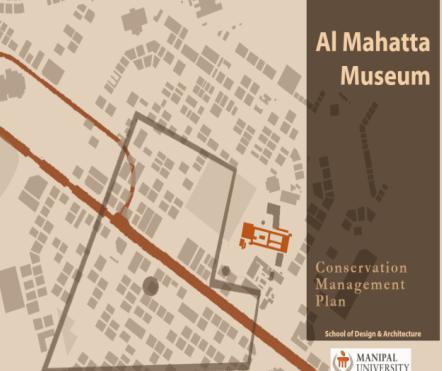
Figure: Conservation Management Plan
Recent Publications
- Ashok G Iyer (2015) Review of approaches to learning adopted by architecture students in the coursework of architectural design archi DOCT. The e-Journal for the Dissemination of Doctoral Research in Architecture; 3(1): 21-30.
- Ashok G Iyer & Andrew Roberts (2014) A Phenomenographic Study in Understanding Architecture Students’ Approaches to Learning the Coursework of Architectural Design. Journal for Education in the Built Environment (JEBE); 9(1): 89-109.
References
- AGI “Approaches to Learning in Architectural Design - A Classification,” Abstract No. 65 in RIBA President’s Awards for Research 2017 - Book of Abstracts.
- AGI & Kairmein Deboo, “Archiving an Impression – Al Mahatta and Sharjah,” Conservation Management Plan and Urban Analysis at Al Mahatta Museum, Sharjah, UAE from June 2017 to Jan 2018
- Poster Presentations
Location: Dubai, UAE

Chair
Manoj Gupta
National University of Singapore, Singapore
Session Introduction
Anumol Thomas
Manipal Academy of Higher Education, Dubai
Title: Illusions in architecture

Biography:
Anumol Thomas is currently a 4th year student of B.Arch in Manipal Academy of Higher Education, Dubai, UAE. Her dissertation topic was focused on illusions in architecture, where she studied the different techniques used to create illusions. She has also focused on different smart materials which brought in kinetism such as interactive movements into architecture.
Abstract:
Visual disruptions are the future of modern designs through illusions in architecture. Optical illusions have long been a useful tool for architects. Perhaps most famously, the ancient Greeks used them in the construction of the Parthenon. The interactive movement in architecture through kinetics is also one method to explain about illusions. The motion of small parts together can largely obtain the concept of kinetic architecture. The current lack of extension in the actual movement application in architecture refers to the complexity of the design and the high cost and difficulty of execution; however the evolution in smart materials makes it simpler and easier. The evolution of architecture from static and stability to dynamic and movement has been accompanied by changes in the architectural thought. The interactive material with wind using kinetics has been explained. Inspired by the beauty of grass blowing in the wind, Super Cilia Skin has become the tactile and visual system. An array of computer-controlled actuators (Cilia) is connected to an elastic membrane. These actuators represent data by changing their physical alignment. It has the potential to replay dynamic gestures over time and to communicate remote gestures; this makes it a potentially important tool for tactual communication and education. These cilia move in response to computer-controlled magnetic fields created under the membrane, allowing them to represent information by dynamically changing their physical orientation. The device is designed to sense physical gestures on the cilia and to replay those gestures by fluttering the same cilia that were tapped. On an architectural scale, a facade superimposed with Super Cilia Skin could represent the “wake” of a local wind pattern blowing up and down the surface during the day generating energy. The entire surface of the facade responds to wind via thousands of 9-inch squares of perforated aluminium mounted on low friction hinges. A photographic mosaic of sand dune images is formed from the perforations of the moving panel. Intricate shadow images of the dunes are projected onto the walls and floor of the building lobby, when sunlight passes through the screens. The optical qualities of the skin alter fiercely with the weather and the time of day.
Image

Figure-1: Super cilia skin.

Figure-2: Movement of super cilia skin in a façade.
References
1.Youssef Osama Elkhayat (2014) Interactive movement in kinetic architecture. Journal of Engineering Sciences Assiut University Faculty of Engineering; 42(3): 816-84.
Aishwarya Thomas
Manipal Academy of Higher Education, Dubai
Title: Sustainable campus design in Dubai promoting physical activity within the built environment

Biography:
Aishwarya Thomas is currently a 4th year student of B.Arch program at MAHE, Dubai campus. The mentioned smart technology including a kinetic energy system and pavagen tiling system, has been referred to for use in her undergraduate thesis project which focuses on creating a sustainable campus, reducing levels of inactivity amongst the youth and young adults and the community as a general in the UAE by establishing certain principles of sustainability within the campus and connecting it to the built environment.
Abstract:
Physical inactivity is a major health threat to the global population and in recent years, there has been an increasing body of literature about the fact that the people in Dubai are not getting enough physical activity. According to a disease study report, the obesity rate in the UAE is double the world average more than 2.1 billion people; close to 30 per cent of the global population are overweight or obese, the World Health Organization says. This project plans to research the relationship between physical inactivity and architecture. It is essential that architectural design be re-thought to increase the physical activity levels within the built environment. An alternative approach needs to be looked at, when talking about the design framework and it should definitely focus on convenience without reducing activity with the increase of physical activity levels. A smart approach to achieve this would be a range of considerations to increase the amount of physical behaviors within an individual to produce energy expenditure by individuals in Dubai. The concept of interaction with buildings where change and response could be connected with the physical movement alongside the building is an interesting concept. A kinetic energy system where pedestrian foot fall could be used to power a digital screen so the building can interact with the physical act of walking past could be thought off. It could create a fun and innovative environment that encourages people to enter a space. With potential uses being, passive walker past or even urban street dance competitions or events. Pavegen tiling systems is a tile based urban design feature that captures the kinetic energy from a pedestrian’s footfall and harvests and/or reuses it to power certain off the grid electrical devices. They will be used throughout the design but mainly with relation to an interactive wall. The kinetic energy from foot fall is stored and used to power the LED lights in the wall to create an interactive relationship between the architecture and the physical activity powering it.
Image
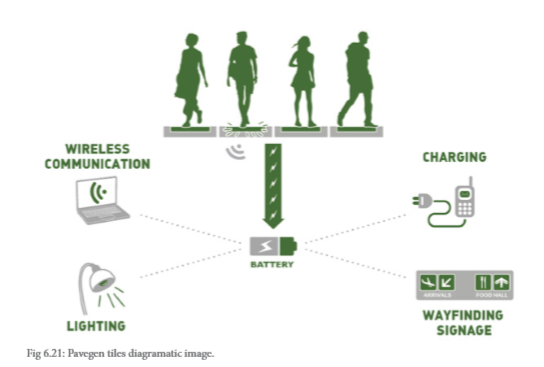
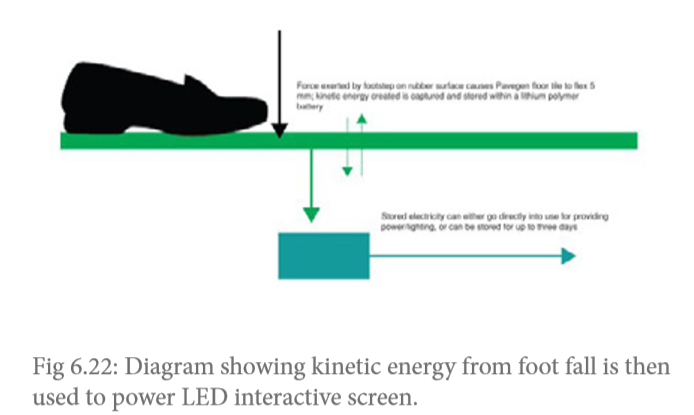
References
1.Cyra, M. (2013). Promoting Physical activity within the built environment
Sundara Vadhana Gurushev
Manipal Academy of Higher Education, Dubai
Title: BioSkin Facades: A reinterpretation of the Mashrabiya

Biography:
Sundara Vadhana Gurushev is currently a 4th year undergraduate student in the B.Arch. program at the School of Design and Architecture at Manipal Academy of Higher Education-Dubai Campus. She is currently working on her design dissertation and thesis on the topic “Archetypes and Identities in Architecture”, that looks at the transition in Emirati Architecture from its vernacular form to the contemporary form. As President of the Conservation and Environment Team at MAHE-Dubai, she has actively been a part of various sustainability initiatives and has led the team to being winners of the Sustainable Campus Initiative by the Environment Agency of Abu Dhabi. She is also a part of the UNGC Local Network as a Youth Ambassador.
Abstract:
Archetype, in Jungian theory, is a primitive mental image inherited from the earliest human ancestors and supposed to be present in the collective unconscious. Identity refers to one’s unique façade, so to speak, in this case, a country’s history or culture. Vernacular Architecture is referred to as ‘Architecture of the People’. It becomes a language of form and culture which gives rise to identities unique to its context. Architectural identities, however, do not necessarily mean monuments or magnificent structures. The architectural identity of a region can be found in the most basic houses of the region. This study focuses on the vernacular design elements that can be reinterpreted and adapted into present day architecture of the gulf. Sudare, the famous Japanese bamboo blinds and Uchimizu, a Japanese air-cooling technique that uses water-spray to cool the surroundings. These were the foundations of the BioSkin Facade system, developed by Nikken Sekkei for the Sony Tower in Osaka back in 2011. The reinterpretation of two ancient techniques by infusing them with existing technology, won the company the CTBUH 2014 award for Innovation. The system uses ceramic pipes which have rainwater harvested on the rooftop running through them. These pipes are exposed to the heat of the buildings surroundings which lets the water evaporate, thus, cooling the immediate surroundings. This second skin facade of Sony Tower reduces its cooling load while also eliminating Urban Heat Island Effect. The concept is similar to that of a Mashrabiya found in the gulf region. The Mashrabiya in olden times was an intricately carved screen that sometimes had a pot of water that cooled the hot air passing through the screen. Applying a similar concept to the gulf region, the BioSkin Facades could be applied in this region as well. Although the system uses rainwater, something that is not found in the gulf; the water could instead be replaced with grey water, which is found globally and can be sourced from the building itself. This would mean the existence of a second skin system that can be adapted and used globally, even in regions where rainwater harvesting is not feasible.
Image
References
1. Oliver, P. (2014). Built to Meet Needs.
2. Yamanashi, T. &. (2011). BIO SKIN urban cooling facade. Architectural Design.
3. Fathy, H. (1989). Natural Energy and Vernacular Architecture: Principles and Examples with Reference to Hot Arid Climates. United Nations University.
Saigeethalakshmi
Manipal Academy of Higher Education, Dubai
Title: Industrial architecture through a textile factory

Biography:
Saigeethalakshmi is a student of Manipal Academy of Higher Education, U.A.E. Her current thesis project focusses on designing a textile factory which will show the industrial architecture and the concept of the free flowing concrete texture on the building façade. The probable conclusion that would come in the future is to challenge and show that factory, industrial architecture and design also has to narrate its own story.
Abstract:
When we think of factories or any industrial buildings, beauty’s usually not the first thing to come to mind, but apparently think of dirt, mud, toxic waste, impurity contamination, dim and dull box like warehouse structures with no sunlight entry inside. But this is not the truth. Factory buildings repeatedly offer a chance for architects to experiment with form, materiality, and structural techniques. Beauty in industrial architecture conveys various factors including exterior design, interior functionality, environmental efficiency and landscape layout. All of them have to narrate their story.
The product named “Crushed wall” is the latest architectural installation designed by British artist Walter Jack (Pic: 1 & 2) which tells how the texture and the form of textiles can be used to create architecture. This material is designed at the entrance of the heartlands project in Cornwall, UK, the expansive 40-metre long, 3-metre high wall utilizes concrete in such a way that it appears as soft and malleable, partially wrapping around the perimeter of a building.
The product being concrete has tried to reflect the fluidity of textile. Material used is Bardon Cemflow A, a free flowing, self-compacting mix of concrete of an architectural grade, used for finishes, a sheet of rubber and plywood. Concrete isn’t known for its tactile qualities also not noted for its fluid softness. And yet it is a liquid. The challenge of this concrete material is to retain continuity of the fluid form of concrete and mirror it with the textile texture accuracy to ensure continuity of form. Benefits of the material: Reduced labour requirements and lower site noise levels, flexible placing options and reductions of placing and finishing time and improved output in precast environments.
Images
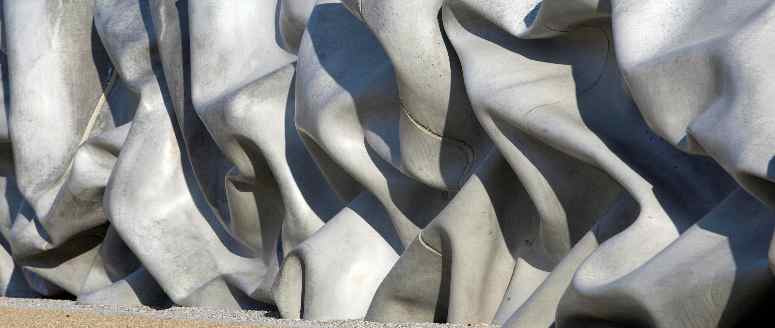
References
|
[1] |
"AGGREGATE INDUSTRIES," March 2014. [Online]. Available: https://www.aggregate.com/sites/aiuk/files/atoms/files/aggregate-industries-concrete-ready-mix-cemflow-tds.pdf. |
|
[2] |
"BARDON CONCRETE," August 2011. [Online]. Available: https://www.barbourproductsearch.info/Bardon-Concrete-brochure-2011v-file030891.pdf. |
|
[3] |
"designboom," 2016. [Online]. Available: https://www.designboom.com/art/walter-jack-studio-crushed-wall/. |
|
[4] |
"AGGREGATE INDUSTRIES," 2016. [Online]. Available: https://www.aggregate.com/sites/aiuk/files/atoms/files/concrete_commitment_brochure_4.pdf. |
Christy Paul Joseph
Manipal Academy of Higher Education, Dubai
Title: Eco-Panelling: Parametric solutions for façade configurations

Biography:
Christy Paul Joseph is a student currently enrolled in the 4th Year of the Bachelors in Architecture (B.Arch) Program in MAHE Manipal, Dubai Campus, UAE. His research largely revolves around the interpretative planning and schematic implementation of a design that echoes the character of a renowned genius, Leonardo Da Vinci. The design aims at complementing the tropical climate in its site of inception, while incorporating parametric façade skins that envelope the organic framework while generating a daylit illuminance in the exhibition space.
Abstract:
Eco-Panelling is about the development of building envelope solutions for tropical humid climates involving passive control of thermal gains on their surfaces, allowing for better internal conditions and thermal comfort without the use of thermal machine. Environmental principles, design and technological aspects are specifically defined based on the peculiar conditions (ego climatic, technological of biodiversity and economic) present in the Middle Eastern low altitude regions, marked by constant high temperatures. Thermal and CFD simulations orient the process of experimental verification through parametric design. Within the design component presented here; different stages of development can be defined. It involves a wide literature review and the analysis of various façade configurations, placing emphasis on those solutions of a local nature and responding to the climatic conditions of the particular case of interest i.e. hot and humid climates. A number of designs were compiled and 3D modelled for the purple of analysis. Following that, a general structure was proposed guided by 3 main determining factors: functional, technological and environmental. Each group had specific factors and was translated into design possibilities but the changing parameters, their relative values and simulation based evaluations producing a conceptual parametric structure. Having defined and developed the parametric design structure the final stage looks for a particular implementation of such model where the generic values given to materials nad design technologies will be replaced by commercially available, low embedded and energy components that showed high performance levels in pre evaluations of their environmental and functional behaviour.
Image:
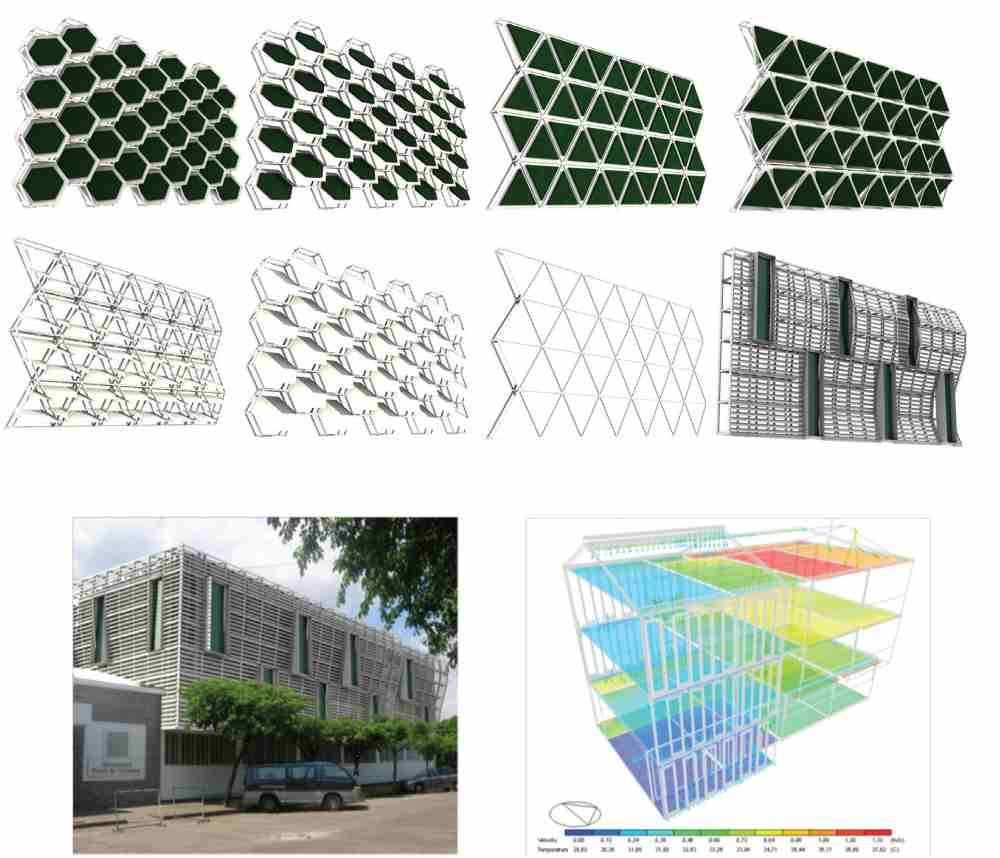
Figure : Examples of geometrical configurations produced from the parametric definition, and CFD analysis of an application to the selected building, half with the original cladding, half with a generated system using non coplanar elements in clay. The simulation for the 21st of June (hottest day) indicates a 4ºC temp. difference in favour of the generated solution. (Hausladen, 2008)
References
1. Walter Isaacson. (2017). Leonardo Da Vinci. New Orleans: Simon & Schuster.
2. Hausladen, G 2008, ClimateSkin: Building-skin-Concepts that Can Do More with Less Energy, Birkhäuser, Munich
3. Leighton, M & Bader, S 2010, ‘Responsive shading - Intelligent façade systems’, Proceedings of the 30th annual conference of the Association of Computer Aided Design in Architecture ACADIA, New York,. pp. 263-269

